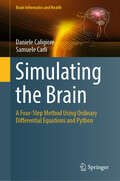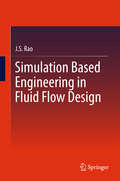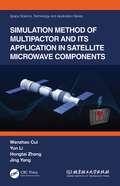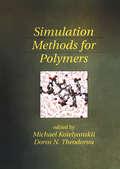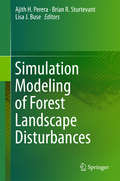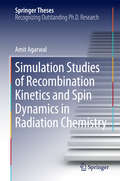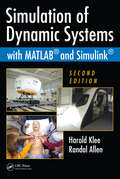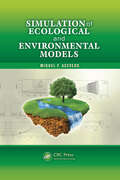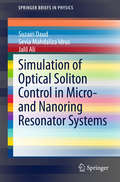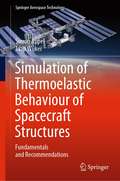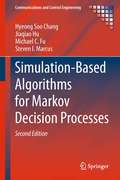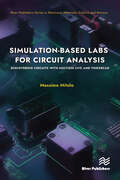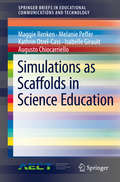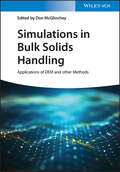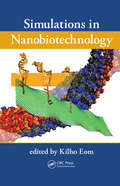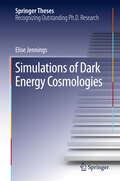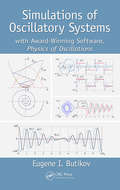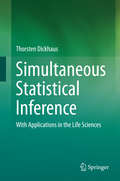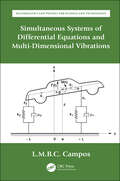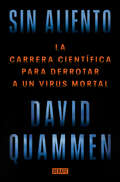- Table View
- List View
Simulating the Brain: A Four-Step Method Using Ordinary Differential Equations and Python (Brain Informatics and Health)
by Daniele Caligiore Samuele CarliThis book presents a new methodology to develop system-level brain models using ordinary differential equations (ODE), which are to be solved and analyzed through simple Python scripts. Computer simulations of this kind of models allow the study of healthy and damaged brain functions, the discovery of new neural pathways that may be crucial for the emergence of pathologies, and to simulate the effects of possible new therapies acting on brain actors which are difficult to investigate in traditional research.The methodology consists of four steps: (i) design the model architecture which represents the interactions between different brain areas; (ii) write the ODE system which are implied by the model; (iii) build a Python script that correctly solves the equations; (iv) optimize the free model parameters using genetic algorithms or other techniques to obtain one or more model instances that reproduce the target investigated behavior.This book is for all people who want to learn how to use Python and ODE to simulate brain functions regardless of their backgrounds. While rigorous mathematical proofs of many aspects of the arguments discussed are out of the scope of this work and are therefore omitted, the most important concepts necessary for the critical judgment and self-assessment of the practitioner’s work are exposed in a simplified, readily applicable form, with extensive references for the adventurous reader to explore. The book is a self-consistent textbook containing all pieces necessary to learn from scratch: from the essential mathematical and computing tools to the knowledge necessary to design, simulate, visualize, and interpret brain models. These skills are acquired through several hands-on examples explained step-by-step. One important and distinctive aspect of the book is that, beside the theory, it provides the necessary contexts and practical examples which are key to the correct application of the proposed methodology.
Simulation Based Engineering in Fluid Flow Design
by J. S. RaoThis volume offers a tool for High Performance Computing (HPC). A brief historical background on the subject is first given. Fluid Statics dealing with Pressure in fluids at rest, Buoyancy and Basics of Thermodynamics are next presented. The Finite Volume Method, the most convenient process for HPC, is explained in one-dimensional approach to diffusion with convection and pressure velocity coupling. Adiabatic, isentropic and supersonic flows in quasi-one dimensional flows in axisymmetric nozzles is considered before applying CFD solutions. Though the theory is restricted to one-dimensional cases, three-dimensional CFD examples are also given. Lastly, nozzle flows with normal shocks are presented using turbulence models. Worked examples and exercises are given in each chapter. Fluids transport thermal energy for its conversion to kinetic energy, thus playing a major role that is central to all heat engines. With the advent of rotating machinery in the 20th century, Fluid Engineering was developed in the form of hydraulics and hydrodynamics and adapted in engineering Schools across the world until recent times. With the High Performance Computing (HPC) in recent years, Simulation Based Engineering Science (SBES) has gradually replaced the conventional approach in Fluid Flow Design bringing Science directly into Engineering without approximations. Hence this SpringerBrief in Applied Sciences and Technology. This book brings SBES to an entry level allowing young students to quickly adapt to modern design practices.
Simulation Method of Multipactor and Its Application in Satellite Microwave Components (Space Science, Technology and Application Series)
by Yun Li Jing Yang Wanzhao Cui Hongtai ZhangThis book combines the experience and achievements in engineering practice of the China Academy of Space Technology, Xi’an, with a focus on the field of high-power multipactor over recent decades. It introduces the main concepts, theories, methods and latest technologies of multipactor simulation, at both the theoretical level and as a process of engineering, while providing a comprehensive introduction to the outstanding progress made in the research technology of multipactor numerical simulation in China. At the same time, a three-dimensional numerical simulation method of multipactor for typical high-power microwave components of spacecraft is introduced. This book is an essential volume for engineers in the field of high-power microwave technology. It can also be used as a reference for researchers in related fields, or as a teaching reference book for graduate students majoring in Astronautics at colleges and universities.
Simulation Methods for Polymers
by Doros N. Theodorou Michael KotelyanskiiSynthetic Lubricants and High-Performance Functional Fluids, Second Edition offers state-of-the-art information on all the major synthetic fluids, describing established products as well as highly promising experimental fluids with commercial potential. This second edition contains chapters on polyinternalolefins, polymer esters, refrigeration lube
Simulation Modeling of Forest Landscape Disturbances
by Ajith H. Perera Lisa J. Buse Brian R. SturtevantForest landscape disturbances are a global phenomenon. Simulation models are an important tool in understanding these broad scale processes and exploring their effects on forest ecosystems. This book contains a collection of insights from a group of ecologists who address a variety of processes: physical disturbances such as drought, wind, and fire; biological disturbances such as defoliating insects and bark beetles; anthropogenic influences; interactions among disturbances; effects of climate change on disturbances; and the recovery of forest landscapes from disturbances--all from a simulation modeling perspective. These discussions and examples offer a broad synopsis of the state of this rapidly evolving subject.
Simulation Studies of Recombination Kinetics and Spin Dynamics in Radiation Chemistry
by Amit AgarwalAmit Agarwal's thesis reports a substantial contribution to the microscopic simulation of radiation chemical reactions. In his research Agarwal extends existing models to further understand scavenging, spin and relaxation effects This research has advanced the development of both the Monte Carlo Random Flights and the Independent Reaction Times (IRT) simulation tools Particular highlights are the extension of these tools to include both the spin-exchange interaction and spin relaxation, both of which are influential in radiolytic systems where many reactions are spin-controlled In addition, the study has led to the discovery of a novel correlation of the scavenging rate with the recombination time in low permittivity solvents. This finding goes against existing assumptions underlying the theory of diffusion kinetics while still being accommodated in the IRT method which demonstrates the power of this unconventional approach. The work in this thesis can be applied to a wide number of fields including the nuclear industry, medicine, food treatment, polymer curing, the preparation of nano-colloids, power generation and waste disposal.
Simulation Tools and Methods for Supercritical Carbon Dioxide Radial Inflow Turbine: Development and Application on Open-Source Code
by Jianhui QiTo protect the Earth, China has launched its target of peaking carbon dioxide emissions by 2030, and achieving carbon neutrality by 2060 , which greatly encourages the use and development of renewable energy. Supercritical CO2 power cycle is a promising technology and the radial inflow turbine is the most important component of it, whose design and optimisation are considered as great challenges. This book introduces simulation tools and methods for supercritical CO2 radial inflow turbine, including a high fidelity quasi-one-dimensional design procedure, a non-ideal compressible fluid dynamics Riemann solver within open-source CFD software OpenFOAM framework, and a multi-objective Nelder–Mead geometry optimiser. Enhanced one-dimensional loss models are presented for providing a new insight towards the preliminary design of the supercritical CO2 radial inflow turbine. Since the flow phenomena within the blade channels are complex, involving fluid flow, shock wave transmission and boundary layer separation, only employing the ideal gas model is inadequate to predict the performance of the turbine. Thus, a non-ideal compressible fluid dynamics Riemann solver based on OpenFOAM library is developed. This book addresses the issues related to the turbine design and blade optimization and provides leading techniques. Hence, this book is of great value for the readers working on the supercritical CO2 radial inflow turbine and understanding the knowledge of CFD and turbomachinery.
Simulation of Additive Manufacturing using Meshfree Methods: With Focus on Requirements for an Accurate Solution (Lecture Notes in Applied and Computational Mechanics #97)
by Christian WeißenfelsThis book provides a detailed instruction to virtually reproduce the processes of Additive Manufacturing on a computer. First, all mathematical equations needed to model these processes are presented. Due to their flexibility, meshfree methods represent optimal computational solution schemes to simulate Additive Manufacturing processes. On the other hand, these methods usually do not guarantee an accurate solution. For this reason, this monograph is dedicated in detail to the necessary criteria for computational solution schemes to provide accurate results. Several meshfree methods are examined with respect to these conditions. Two different 3D printing techniques are presented in detail. The results obtained from the simulation are investigated and compared with experimental data. This work is addressed to both scientists and professionals working in the field of development who are interested to learn the secrets behind meshfree methods or get into the modeling of Additive Manufacturing.
Simulation of Dynamic Systems with MATLAB and Simulink
by Harold Klee Randal Allen"� a seminal text covering the simulation design and analysis of a broad variety of systems using two of the most modern software packages available today. � particularly adept [at] enabling students new to the field to gain a thorough understanding of the basics of continuous simulation in a single semester, and [also provides] a more advanced tre
Simulation of Ecological and Environmental Models
by Miguel F. AcevedoGiven the importance of interdisciplinary work in sustainability, Simulation of Ecological and Environmental Models introduces the theory and practice of modeling and simulation as applied in a variety of disciplines that deal with earth systems, the environment, ecology, and human-nature interactions. Based on the author's many years of teaching g
Simulation of Fluid Power Systems with Simcenter Amesim
by Nicolae Vasiliu Daniela Vasiliu Radu Puhalschi Constantin CălinoiuThis book illustrates numerical simulation of fluid power systems by LMS Amesim Platform covering hydrostatic transmissions, electro hydraulic servo valves, hydraulic servomechanisms for aerospace engineering, speed governors for power machines, fuel injection systems, and automotive servo systems It includes hydrostatic transmissions, automotive fuel injection, hydropower speed units governor, aerospace servo systems along with case studies of specified companies Aids in predicting and optimizing the static and dynamic performances related to the systems under study
Simulation of Optical Soliton Control in Micro- and Nanoring Resonator Systems
by Sevia Mahdaliza Idrus Suzairi Daud Jalil AliThis book introduces optical soliton control in micro- and nanoring resonator systems. It describes how the ring resonator systems can be optimized as optical tweezers for photodetection by controlling the input power, ring radii and coupling coefficients of the systems. Numerous arrangements and configurations of micro and nanoring resonator systems are explained. The analytical formulation and optical transfer function for each model and the interaction of the optical signals in the systems are discussed. This book shows that the models designed are able to control the dynamical behaviour of generated signals.
Simulation of Thermoelastic Behaviour of Spacecraft Structures: Fundamentals and Recommendations (Springer Aerospace Technology)
by Jaap Wijker Simon AppelThis book provides recommendations for thermal and structural modelling of spacecraft structures for predicting thermoelastic responses. It touches upon the related aspects of the finite element and thermal lumped parameter method. A mix of theoretical and practical examples supports the modelling guidelines. Starting from the system needs of instruments of spacecraft, the reader is supported with the development of the practical requirements for the joint development of the thermal and structural models. It provides points of attention and suggestions to check the quality of the models.The temperature mapping problem, typical for spacecraft thermoelastic analysis, is addressed. The principles of various temperature mapping methods are presented. The prescribed average temperature method, co-developed by the authors, is discussed in detail together with its spin-off to provide high quality conductors for thermal models. The book concludes with the discussion of the application of uncertainty assessment methods. The thermoelastic analysis chain is computationally expensive. Therefore, the 2k+1 point estimate method of Rosenblueth is presented as an alternative for the Monte Carlo Simuation method, bringing stochastic uncertainty analysis in reach for large thermoelastic problems.
Simulation-Based Algorithms for Markov Decision Processes
by Hyeong Soo Chang Steven I. Marcus Michael C. Fu Jiaqiao HuMarkov decision process (MDP) models are widely used for modeling sequential decision-making problems that arise in engineering, economics, computer science, and the social sciences. Many real-world problems modeled by MDPs have huge state and/or action spaces, giving an opening to the curse of dimensionality and so making practical solution of the resulting models intractable. In other cases, the system of interest is too complex to allow explicit specification of some of the MDP model parameters, but simulation samples are readily available (e.g., for random transitions and costs). For these settings, various sampling and population-based algorithms have been developed to overcome the difficulties of computing an optimal solution in terms of a policy and/or value function. Specific approaches include adaptive sampling, evolutionary policy iteration, evolutionary random policy search, and model reference adaptive search. This substantially enlarged new edition reflects the latest developments in novel algorithms and their underpinning theories, and presents an updated account of the topics that have emerged since the publication of the first edition. Includes: innovative material on MDPs, both in constrained settings and with uncertain transition properties; game-theoretic method for solving MDPs; theories for developing roll-out based algorithms; and details of approximation stochastic annealing, a population-based on-line simulation-based algorithm. The self-contained approach of this book will appeal not only to researchers in MDPs, stochastic modeling, and control, and simulation but will be a valuable source of tuition and reference for students of control and operations research.
Simulation-based Labs for Circuit Analysis: Discovering Circuits with Multisim Live and Tinkercad (River Publishers Series in Electronic Materials, Circuits and Devices)
by Massimo Mitolo"Simulation-based Labs for Circuit Analysis" brings you an unparalleled learning experience, integrating cutting-edge simulation tools, Multisim Live and Tinkercad, to explore the realm of circuits.Circuit analysis is the cornerstone of electrical and electronic engineering, and with the advent of advanced simulation software, learning has taken a transformative turn. Delve into a virtual laboratory environment that replicates real-world circuit experiments with precision and flexibility, allowing you to grasp complex concepts effortlessly. Recreate experiments multiple times, gaining deeper insights into circuit characteristics and behavior across various scenarios.Aspiring engineers and technicians, circuit enthusiasts, and educators will find "Simulation-based Labs for Circuit Analysis" an indispensable resource for unlocking the boundless possibilities of circuit analysis in the digital age. Whether you are a student seeking to excel in your studies or a professional looking to refine your engineering skills, this book will empower you to innovate, explore, and experiment without limits.
Simulations as Scaffolds in Science Education
by Maggie Renken Melanie Peffer Kathrin Otrel-Cass Isabelle Girault Augusto ChiocarrielloThis book outlines key issues for addressing the grand challenges posed to educators, developers, and researchers interested in the intersection of simulations and science education. To achieve this, the authors explore the use of computer simulations as instructional scaffolds that provide strategies and support when students are faced with the need to acquire new skills or knowledge. The monograph aims to provide insight into what research has reported on navigating the complex process of inquiry- and problem-based science education and whether computer simulations as instructional scaffolds support specific aims of such pedagogical approaches for students.
Simulations in Bulk Solids Handling: Applications of DEM and other Methods
by Don McGlincheySimulations in Bulk Solids Handling Valuable resource for engineers and professionals dealing with bulk granular or powdered materials across industries using Discrete Element Methods (DEM) In many traditional university engineering programmes, no matter whether undergraduate or postgraduate, the behavior of granular materials is not covered in depth or at all. This omission leaves recent engineering graduates with little formal education in the major industrial area of bulk solids handling. This book teaches young professionals and engineers to find appropriate solutions for handling granular and powdered materials. It also provides valuable information for experienced engineers to gain an understanding and appreciation of the most significant simulation methods–DEM chief amongst them. For any student or professional involved with bulk solids handling, this book is a key resource to understand the most efficient and effective stimulation methods that are available today. Its comprehensive overview of the topic allows for upcoming professionals to ensure they have adequate knowledge in the field and for experienced professionals to improve their skills and processes.
Simulations in Nanobiotechnology
by Kilho EomUntil the late 20th century, computational studies of biomolecules and nanomaterials had considered the two subjects separately. A thorough presentation of state-of-the-art simulations for studying the nanoscale behavior of materials, Simulations in Nanobiotechnology discusses computational simulations of biomolecules and nanomaterials together. Th
Simulations of Dark Energy Cosmologies
by Elise JenningsA major outstanding problem in physics is understanding the nature of the dark energy that is driving the accelerating expansion of the Universe. This thesis makes a significant contribution by demonstrating, for the first time, using state-of-the-art computer simulations, that the interpretation of future galaxy survey measurements is far more subtle than is widely assumed, and that a major revision to our models of these effects is urgently needed. The work contained in the thesis was used by the WiggleZ dark energy survey to measure the growth rate of cosmic structure in 2011 and had a direct impact on the design of the surveys to be conducted by the European Space Agency's Euclid mission, a 650 million euro project to measure dark energy.
Simulations of Oscillatory Systems: with Award-Winning Software, Physics of Oscillations
by Eugene I. ButikovDeepen Your Students' Understanding of Oscillations through Interactive ExperimentsSimulations of Oscillatory Systems: with Award-Winning Software, Physics of Oscillations provides a hands-on way of visualizing and understanding the fundamental concepts of the physics of oscillations. Both the textbook and software are designed as exploration-orien
Simultaneous Catalytic Removal of Diesel Soot and NOx (Energy and Environment Research in China)
by Wenfeng Shangguan Guchu Zou Zhi JiangThis book not only explores catalysis processes in redox reactions but also proposes a potential after-treatment strategy. Summarizing the authors’ major works, it offers a guidebook for those working on environmental and industrial catalysis. It presents insights into reaction kinetics in a variety of materials and analyzes the external conditions influencing the reaction. As such it is of particular interest to engineers and scientists in the field of material chemistry, chemical engineering and automobile industry. With novel images and illustrations, it provides a new perspective for interpreting soot abatement material and understanding the reaction process and inspires scientists to design new catalysts with moderate redox capacity.
Simultaneous Statistical Inference
by Thorsten DickhausThis monograph will provide an in-depth mathematical treatment of modern multiple test procedures controlling the false discovery rate (FDR) and related error measures, particularly addressing applications to fields such as genetics, proteomics, neuroscience and general biology. The book will also include a detailed description how to implement these methods in practice. Moreover new developments focusing on non-standard assumptions are also included, especially multiple tests for discrete data. The book primarily addresses researchers and practitioners but will also be beneficial for graduate students.
Simultaneous Systems of Differential Equations and Multi-Dimensional Vibrations (Mathematics and Physics for Science and Technology)
by Luis Manuel Braga da Costa CamposSimultaneous Differential Equations and Multi-Dimensional Vibrations is the fourth book within Ordinary Differential Equations with Applications to Trajectories and Vibrations, Six-volume Set. As a set, they are the fourth volume in the series Mathematics and Physics Applied to Science and Technology. This fourth book consists of two chapters (chapters 7 and 8 of the set). The first chapter concerns simultaneous systems of ordinary differential equations and focuses mostly on the cases that have a matrix of characteristic polynomials, namely linear systems with constant or homogeneous power coefficients. The method of the matrix of characteristic polynomials also applies to simultaneous systems of linear finite difference equations with constant coefficients. The second chapter considers linear multi-dimensional oscillators with any number of degrees of freedom including damping, forcing, and multiple resonance. The discrete oscillators may be extended from a finite number of degrees-of-freedom to infinite chains. The continuous oscillators correspond to waves in homogeneous or inhomogeneous media, including elastic, acoustic, electromagnetic, and water surface waves. The combination of propagation and dissipation leads to the equations of mathematical physics. Presents simultaneous systems of ordinary differential equations and their elimination for a single ordinary differential equation Includes cases with a matrix of characteristic polynomials, including simultaneous systems of linear differential and finite difference equations with constant coefficients Covers multi-dimensional oscillators with damping and forcing, including modal decomposition, natural frequencies and coordinates, and multiple resonance Discusses waves in inhomogeneous media, such as elastic, electromagnetic, acoustic, and water waves Includes solutions of partial differential equations of mathematical physics by separation of variables leading to ordinary differential equations
Sin aliento: La carrera científica para derrotar a un virus mortal
by David QuammenLa apasionante crónica de la carrera contrarreloj para descifrar el SARS-CoV-2 y frenar una pandemia devastadora. Finalista del National Book Award «Unacrónica iluminadora y apasionada de la crisis que ha definido nuestro tiempo».The New York Times David Quammen, uno de los mejores escritores científicos del mundo y autor de Contagio (Debate, 2020), la obra de referencia sobre enfermedades zoonóticas (las que saltan de animales a humanos), nos sumerge en la frenética carrera por descifrar el coronavirus SARS-CoV-2, encontrar su origen y hacer posible el desarrollo de vacunas para combatir la pandemia de COVID-19. Tras entrevistar a casi un centenar de científicos, entre ellos los virólogos más importantes del panorama internacional, Quammen denuncia cómo durante décadas los expertos advirtieron de que esta pandemia llegaría, pero sus consejos fueron ignorados por razones económicas o políticas. Además, también se encarga de descifrar las claves para entender algunas teorías sobre el origen del virus y descartar otras suposiciones más escandalosas pero menos fiables. Este libro nos traslada a la primera línea de batalla contra la COVID-19 a través de los ojos de aquellos científicos que lideraron esta lucha, y lo hace con la prosa comprensible y reveladora de un maestro incomparable como Quammen. La crítica ha dicho:«Relata con apasionante detalle la respuesta científica a la pandemia del Covid-19. Una lectura obligada».Publishers Weekly «Sin aliento es lo más parecido que tenemos a una historia rigurosa de los orígenes del virus hasta las vacunas y variantes, contada a través de los científicos implicados y de la característica prosa ágil de Quammen. Se lee como un thriller a tiempo real».Chicago Tribune«Quizá el verdadero valor de este libro radique en que Quammen aporta la mirada de un naturalista a estos debates. Al final, uno se queda con una profunda apreciación de la diversidad de la naturaleza y la casualidad de la selección natural, que todos los días está barajando y reorganizando los genomas de los virus de maneras que los científicos sólo pueden empezar a imaginar».The GuardianSobre Ébola:«Una aterradora y fascinante obra maestra de divulgación científica que se lee como una historia de suspense.»Walter Isaacson «David Quammen es una estrella deslumbrante de la literatura científica.»Edward O. Wilson Sobre El árbol enmarañado:«Mucho más que un reportaje sobre algunos hechos científicos atractivos; es una auténtica fuente de maravillas».Thomas Levenson, The Boston Globe «Una obra maestra de un nuevo campo de la biología molecular [...] un relato impresionante sobre quizás la revolución científica más desconocida del siglo XX.»Kirkus Reviews Sobre Contagio:«El libro que me ayudó a entender la dinámica de lo que estaba pasando.»Paolo Giordano«Deslumbrante Quammen: desvela lo que nos hace vivir y lo que nos mata con pasión, humor y conocimiento.»Daniel Arjona, El confidencial
Sind wir noch zu retten?: Wie wir mit neuen Technologien die Natur verändern können
by Christopher J. PrestonNanotechnologie, synthetische Biologie, Wiedererweckung ausgestorbener Arten und Geoengineering – werden Menschen die Natur in Zukunft mit solchen Methoden grundlegend umgestalten? Man könnte es sich vorstellen.Auf der Erde gibt es keinen von Menschen unberührten Ort mehr – das hat wohl jeder schon einmal gehört. Aber die Bedeutung dieser Tatsache erschöpft sich nicht in Statistiken, die Gletscherschmelze und Artensterben dokumentieren. Vielmehr kennzeichnet sie den Beginn einer neuen Epoche der Erdgeschichte. Und das Auffälligste an diesem Synthetischen Zeitalter, so Christopher Preston, sind nicht nur die Auswirkungen des Menschen als solche, sondern die Veränderungen, die wir von nun an gezielt und absichtlich herbeiführen werden. Neue Technologien werden uns die Macht verleihen, viele grundlegende Abläufe der Natur selbst in die Hand zu nehmen. Damit verlassen wir nicht nur das Holozän und treten ins Anthropozän ein; wir lassen auch eine Zeit hinter uns, in der globaler Wandel nicht nur die unbeabsichtigte Folge einer ungezügelten Industrialisierung ist. Mit einer von Ingenieuren und Technikern gestalteten Welt beginnt das erste Synthetische Zeitalter unseres Planeten.Preston beschreibt eine Reihe von Technologien, die den „Stoffwechsel“ der Erde umgestalten werden: Nanotechnologie gibt den natürlichen Formen der Materie eine neue Struktur; „molekulare Produktion“ eröffnet unzählige neue Anwendungsmöglichkeiten; synthetische Biologie erlaubt es uns, Genome nicht nur zu lesen, sondern auch aufzubauen; „biologische Mini-Maschinen“ überflügeln die Evolution; Arten werden umgesiedelt und wieder zum Leben erweckt; und mit Geoengineering kann man die Sonnenstrahlung mit Vulkandunst abschirmen, die Temperaturen auf der Erde durch hellere Wolken senken und mit künstlichen Bäumen, die Kohlenstoff aus Wind gewinnen, das CO2 aus der Atmosphäre beseitigen.Was bedeutet es, wenn Menschen die Erde nicht nur verwalten, sondern auch grundlegend umgestalten? Und wem sollten wir vertrauen, wenn es darum geht, über die Umrisse unserer synthetischen Zukunft zu entscheiden? Solche Fragen sind zu wichtig, als dass man sie den Ingenieuren überlassen sollte.
